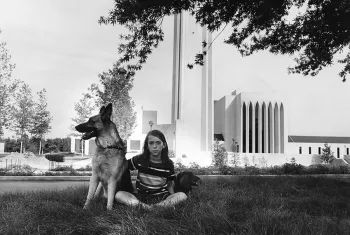The National Presbyterian Church
A National Sacred Space Page 1
"[The national church] should be conspicuously located and courageously and generously financed, so that when completed it will be a structure to be known of all who come to Washington, a monument to the zeal, liberality and foresight of the Presbyterian Church."
—Report of the National Capital Presbyterian Commission, 1924

The first formal steps towards establishing a national Presbyterian church occurred in 1924, when the General Assembly of the Presbyterian Church in the U.S.A. (PCUSA), at the request of the Presbytery of Washington City, appointed a commission to explore the possibility. This commission cited the need for the Presbyterian Church to keep up with its peers and “take its proper place” in the increasingly important District of Columbia. The idea was not new; it had first been proposed in 1803. The commission continued its work, and in 1930, selected the congregation of the Church of the Covenant (later Covenant-First) Presbyterian Church to be the foundation of the National Presbyterian Church.

It took another seventeen years for the legal and financial pieces to fall into place. Finally, in March 1947, the Presbytery of Washington City approved the congregation’s name change. The General Assembly passed a resolution two months later, and thus the National Presbyterian Church was established as the representative church of the PCUSA in this country, while also being a local congregation. Owing to its creation by the General Assembly, the church was required to fulfill certain obligations, such as allowing the moderator of the assembly to preach from its pulpit at least once a year.

The aspirations for the National Presbyterian Church quickly evolved into a large-scale program and related center. To drum up support for the necessary physical expansion, the National Presbyterian Church rallied sponsors from far and near—congregations across the country, politicians, government appointees, and individuals of means who believed in the mission of the church and center—to:
- be a voice for the Presbyterian church in the political center of the nation
- represent the contributions of Presbyterians to the founding principles of the country
- support ecumenical causes and interdenominational cooperation
- influence international affairs
- welcome visitors to the capital
- carry on the tradition of Presbyterians’ active involvement in civic life
Reverend Edward L.R. Elson Page 2
The Reverend Dr. Edward L. R. Elson (1906-1993), pastor of the National Presbyterian Church (1947-1973) and Chaplain of the Senate (1969-1981), played a particularly active role in advocating for a Presbyterian program in Washington, D.C.

He served on the Advisory Council of the National Presbyterian Church, fostered spiritual relationships with elected officials (including President Dwight D. Eisenhower, a member of the congregation whom Elson baptized into the faith), and enthusiastically reached out to potential donors.



Construction of the National Church Page 3
After more than four decades of relationship-building and fund-raising, the new National Presbyterian Church and Center, at Nebraska Avenue and Van Ness Street, N.W., welcomed worshippers in September 1969. Designed by the architectural firm of Harold E. Wagoner, it features white marble and limestone structures in the Neo-Gothic style, a water fountain in the shape of the Celtic cross, and a 173-foot tall Tower of Faith.

The Main Sanctuary seats more than 1,200 worshipers.

Among other decorative windows, the Chapel of the Presidents contains contains six faceted, stained-glass windows by Willet Studio depicting the spirituality of U.S. presidents George Washington, Abraham Lincoln, Theodore Roosevelt, Woodrow Wilson, Franklin D. Roosevelt, and Dwight D. Eisenhower. Throughout the complex, visitors are greeted by passages from the Bible and quotes by noted religious figures, including John Calvin and John Knox.

The campus is a testament to the hard work dedicated by numerous men and women to realize a monumental vision. Next time you find yourself in Washington, D.C., add a visit to the National Presbyterian Church to your itinerary.

